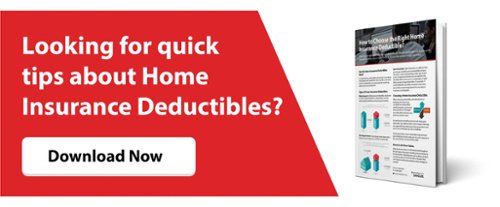Our homes are more than just a roof over our heads. For some of us, it's our most valuable investment. While finding an insurance policy for your investment is hard enough, picking a deductible is no easier.
Choosing the right deductible that complements your lifestyle and budget will set you up for financial flexibility when it matters most. Let's cover the process and get you ready.
What you will learn:
- How do home insurance deductibles work?
- Types of home insurance deductibles
- Deductibles for high risk areas
- Which deductible should you choose?
- How to avoid paying deductibles
How Do Home Insurance Deductibles Work?
In simplest terms, a deductible is the portion of coverage that you pay out-of-pocket for. Once you file a claim and meet your deductible, your policy pays the remaining balance up to your policy limit.
The Insurance Information Institute describes deductibles as the way in which "risk is shared between policyholders and insurers." Higher deductibles mean lower premiums
As you may know, health insurance policies have annual deductible thresholds. Insurers cover all expenses that you incur past your threshold. On the other hand, the home insurance deductibles you choose will apply to every claim filed throughout the year.
Types of Home Insurance Deductibles.
Before choosing a deductible, make sure you understand how deductibles are calculated, and which type best suits your financial needs.
Home insurance deductibles are calculated in three main ways:
- Dollar-amount deductibles
- Percentage-based deductibles
- Split deductibles
Dollar Amount Deductibles
A dollar-amount deductible, also known as a "flat" amount deducible is a fixed dollar sum that must be paid out before your insurer pays its portion. No matter the amount, you have to pay that share of any claim you make as the policyholder.
Let's say you make a claim with damages at $5,000. If your deductible is $1,000, you pay that out-of-pocket before your insurance issues the remaining $4,000 to fix the damages.
Percentage Based Deductibles
A percentage-based deductible is based on a percentage of your home’s insured value.
If your house is insured for $100,000 and your policy has a 2% deductible, $2,000 would be deducted from any claim payment. So, in the event of $15,000 loss, your claim check would be $13,000.
Split Deductibles
Split deductibles are different than percentage and dollar amount deductibles because this policy is paid out depending on the type of peril or loss. So based on the event you are experiencing, this deductibles can be one or a combination of both dollar and percentage deductibles. For example, if a split deductible uses dollar-amount in most cases, but switches to percentage-based for losses due to hurricanes or earthquakes.
Special Deductibles for Special Risk.
If you live in a high risk area that experiences extreme weather, you will have to pay above average premiums and deductibles for certain perils, including earthquakes, flood and hurricanes.
Earthquake Insurance Deductibles
Coverage for earthquakes are not covered by standard insurance policies. By adding an earthquake policy or endorsement, you cover dwelling and personal property. Deductibles for earthquakes are percentage-based and can range anywhere from 2 percent to 20 percent of the structure's replacement value.
Flood Insurance Deductible
Standard homeowners insurance policies typically do not cover damage caused by floods. If you live in a flood zone, you a flood insurance policy. Flood insurance deductibles vary by state and insurer, and can be offered in dollar-amount and percentage-based options.
Hurricanes and Windstorm Deductibles
A standard homeowners policy guards your home from damage from heavy winds. Often times, if you live in a high risk zone for hurricanes and windstorms, you will need a separate policy. States at risk for hurricane damage mandate different deductibles.
- Alabama
- Connecticut
- Delaware
- Florida
- Georgia
- Hawaii
- Louisiana
- Maine
- Maryland
- Massachusetts
- Mississippi
- New Jersey
- New York
- North Carolina
- Pennsylvania
- Rhode Island
- South Carolina
- Texas
- Virginia
- Washington D.C.
Unlike flood and earthquake deductibles, you cannot choose between dollar type and percentage deductibles for wind damage claims since they are already predetermined. Make sure you know your state's deductible for hurricane-related claims to avoid any surprises and maintain your financial stability.
Choosing a Home Insurance Deductible.
When choosing a deductible, your decision lies in balancing the amount you can afford now (deductible) and the long-term cost of your policy (premium). The higher your deductible, the lower your premium, and vice-versa.
By lowering your monthly premium and raising your deductible, you can save money in the long run, especially if you take preventative precautions with your home to eliminate any risks or liabilities.
On the other hand, a lower deductible, high premium plan will help you avoid costly out-of-pocket expenses in the event that you do have to file a claim.
The Case for High/Low Deductible vs. Premium Plans
Before choosing a deductible for your home, first ask: what type of homeowner are you? Are you the proactive type that consistently performs ongoing home maintenance and repair? Or are you the kind that usually waits until a problem arises?
If you are the proactive maintainer, you can probably get away with a high deductible plan. Being proactive with your home maintenance is important, and can make you less likely to suffer damages and report claims.
If you are more of the "if it ain't broke, don't fix it" type, then you might be better suited for a low deductible, high premium plan. Since you don't take preventative measures, you might be more likely to incur property damage and could file more claims than a more proactive homeowner. A low deductible would be better suited for homeowners that typically file more claims.
How to Limit Your Claims.
The smartest way to avoid paying a deductible is to avoid claims! This does NOT mean you should neglect damages. Instead, it means that there are preventative measures homeowners can take to reduce the risk for damages that result from poor maintenance or a lack of safety features.
Pro-Active Home Maintenance
Making sure your home is well maintained throughout the year goes a long way to avoiding claims and paying for deductibles. Inspecting your roof, caulking windows, monitoring pipes are all preventative measures that can help you avoid claims related to water damage for example.
Each season has comes with its own set of maintenance requirements. In the spring, for example, you should clean out the gutters, inspect your HVAC systems, check fire extinguishers, etc. During the Fall and Winter seasons, you might want to insulate pipes, inspect your furnace, clean kitchen exhaust hoods, etc.
Plan Ahead for Severe Weather
Taking precautions that reduce the likelihood of property damage and understanding the limits of your current coverages are the two best ways to plan ahead for dangerous weather conditions.
Never underestimate the importance of preparing for severe weather. If you live in an area that sees harsh winters for example, plan ahead of winter to prevent property damage. If you live in a flood zone, consider a flood insurance policy. We can control pretty much everything except the weather, so be ready when it counts.
Safety First
Being able to think safety-first when it matters is crucial. Think about it, how many preventable accidents have we experienced in life that could have been avoided? Life's most obvious situations are safer with precautions:
- Pool parties are safer with off-duty lifeguards or parents who can swim
- Non-skid rugs or material can prevent slip and falls on your property
- Training and socializing small and large dogs
- Childproofing your home
File Claims Wisely
You can also avoid paying deductibles by only filing a claim when you have to. Not only do claims increase your premium, if you file lots of them, insurance companies will classify you as a "high-risk" homeowner and you'll be given high rates by default.
If you have a minor claim that you can afford to pay out of pocket or fix in house, do it! Sometimes DIY solutions can be less expensive than your deductible.
Trust a Pro-Active Insurance Adviser
Having an insurance adviser than will go above and beyond for you can make all the difference in the world. A pro-active adviser will make sure your premiums and deductibles position you for financial stability. If you own a luxury home, this is even more important because your valuables may not all be covered by your existing policy.
A pro-active adviser will also provide you with all the options available to you that can help driving your premium down, such as bundling your home and auto policies, installing safety measures in your vehicle or even leak detection technology at home.
Conclusion.
Every homeowner has a different approach in choosing the right deductible suited for their needs. It's easier to make a decision about your deductible if you understand that it's a trade-off that you are making. Deciding the best coverage for your situation should not be taken lightly. Understanding and evaluating both your immediate and long-term financial needs of home insurance deductibles will help you ensure the best decisions.




